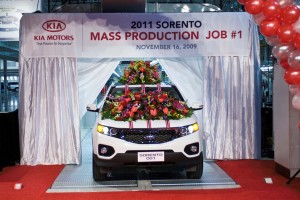
The new Kia assembly plant, in Georgia, will eventually employ 2,500 workers and have a capacity of up to 300,000 vehicles annually.
A white Sorrento crossover vehicle rolled off the assembly line, in West Point, Georgia, today, marking the start of production at Kia’s first U.S. assembly plant.
The new, $1.2 billion facility will eventually employ 2,500 workers on the line, and another 7,500 to support the plant, the automaker said, with production capacity to reach 300,000 vehicles annually.
“The start of production for our first manufacturing facility in the United States further demonstrates our commitment to growth in North America and we are proud to be adding 2,500 jobs to the local economy,” said B.M. Ahn, President and CEO, Kia Motors America (KMA) and KMMG, during a ceremony to mark the opening of the West Point plant.
The opening of the facility follows by roughly a year the inauguration of another U.S. facility operated by Kia’s sibling marque, Hyundai Motor Co.
First announced in 2006, the facility marks a significant shift in strategy for Kia. Like Hyundai, the South Korean carmaker had long counted on the relatively low wages of its home country to help give it a competitive edge over manufacturers like Toyota, Hyundai or General Motors.
It also was pursuing an aggressive export strategy from its protected home market, which is increasingly being called into question by its trading partners in the EU and the U.S. In fact, free trade agreements with both trading blocs are now stalled.
To make up for the wage gap, Kia has adopted a variety of measures to maximize production efficiency, it claims. But the maker is also emphasizing efforts to reduce worker fatigue and injuries at the plant, including the use of height-adjustable conveyors, which can position a vehicle at the optimum work angle. The West Point plant also is the only auto assembly line in North America outfitted with wood flooring, which is far easier to work on than traditional concrete flooring.
The 2,200-acre complex includes a body stamping plant and a transmission facility producing the 6-speed automatic gearbox for the Sorrento. There’s also a 2-mile test track adjacent to the assembly plant.
In a market plagued with over-capacity, Kia can arguably make use of the new factory. It’s one of only three automakers competing in the U.S. whose sales, this year, are running ahead of their pace during the first 10 months of 2008.
